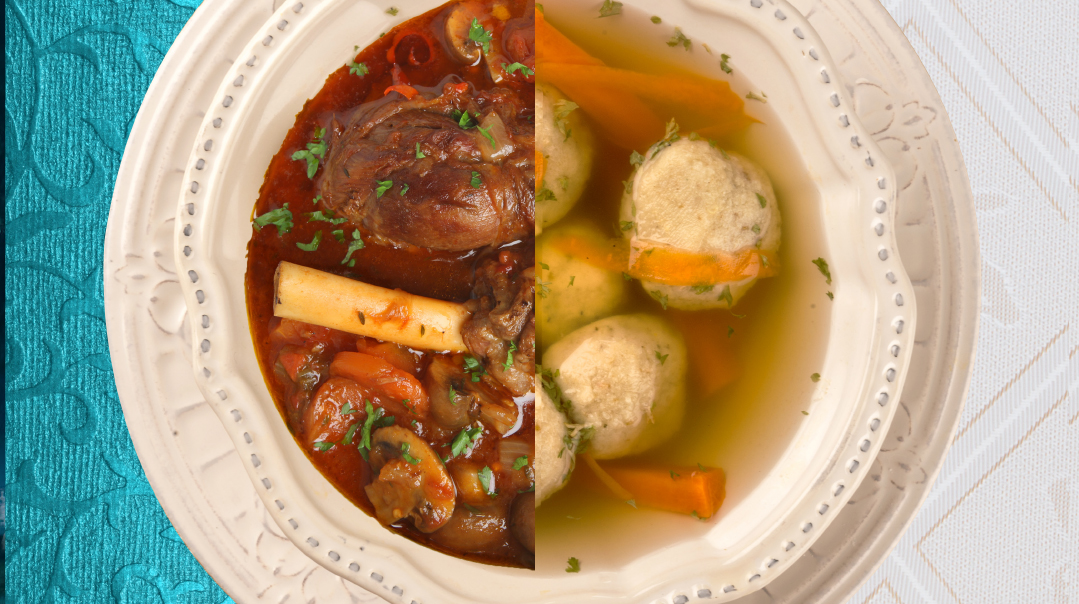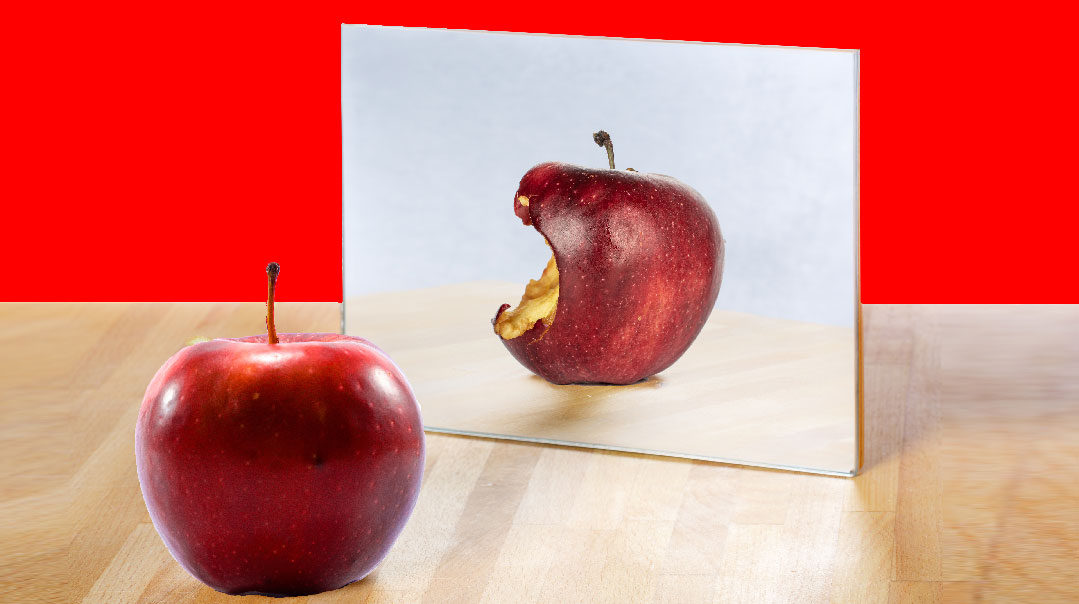Mix & Match: “Ashkesfard” Version

What happens when you match a Sephardi with an Ashkenazi? “Ashkesfard” couples share their stories about the culture shocks, halachic adjustments, and other unexpected surprises

S ally Cohen’s parents are Syrian immigrants — her mother was born in Damascus her father in Qamishli. Arabic was the language spoken in her childhood home and the aromas coming out of her mother’s kitchen were distinctly Syrian with foods like yibra lahmagine and kibbeh prepared every day. Surrounded by Sephardim in her tight-knit community in Brooklyn New York Sally never actually befriended an Ashkenazi peer until high school when she joined a teen Motzaei Shabbos program.
Her greatest exposure to the Ashkenazi world came when she decided to go to seminary in Israel — not a given in very traditional Syrian families. “When I first introduced the idea to my mom ” Sally says “she just blinked at me. ‘Seminary? What’s that?’ ”
It was in Israel that Sally realized just how vast the spectrum of Jewish life really was. “Going away for Shabbos was fascinating because certain minhagim I took for granted were not ‘Jewish across the board’ but simply Sephardi ” she remembers. “One of the first things I learned was that it’s only Sephardim who have the custom of laughing out loud during Havdalah. I learned this the hard way.
“And before the Yamim Tovim I had no idea why my friends were scrambling to purchase a lulav for Succos or a menorah for Chanukah — my father did these things on behalf of the entire household so there was never a need to purchase them for myself.”
Little did Sally realize that one day several years later she’d be comparing prices for lulavim and menorot as well — when she married Simcha Lustig an Ashkenazi young man from Brooklyn with Gerrer chassidish roots.
Making Mixed Shidduchim
In the Olympics of redting “mixed” shidduchim Monsey-based shadchan Chaya Landerer could easily win gold. She’s lost count of the Ashkenazi-Sephardi matches she’s made over the past 25 years.
“I have two out right now” she says with a touch of pride. “Right this second two Sephardi sisters are out on dates with two Ashkenazi boys.”
Mrs. Landerer who was raised in both Switzerland and America says her dual upbringing has made her skilled in putting together couples with disparate backgrounds. She also spends a lot of time listening — her meetings with singles sometimes last two hours (complete with coffee and cake). She says the prerequisites for an “Ashkesfard” marriage to work are a sense of open-mindedness and a positive outlook toward differences: “You need an ayin tovah a sense of flexibility and the ability to get out of your little box of security and comfort and realize that not only is different tolerable different can be better.”
Her most common shidduchim are the ones between Sephardi girls and Ashkenazi boys. “I find that Sephardi girls bring a lot to the table — a lot of warmth spirituality and refinement. There’s a certain kindness a caring… a delicate vibrancy a soft energy… that I find many of my Ashkenazi boys really need. On the other hand ” she says “Ashkenazi men bring an open-mindedness a freshness to the equation.”

There are benefits the other way too says Mrs. Landerer. “Ashkenazi girls bring open honest communication to the relationship. They are often very comfortable in their own skin and not afraid to tackle a challenge — they have a can-do attitude that Sephardi boys respect as long as the girls are not too independent and still retain their femininity.
“Meanwhile the Sephardi boys possess a tremendous amount of inner strength — they very often are the stereotypical ‘real men.’ Usually very ambitious they want to succeed in life both in attaining high goals in their Yiddishkeit as well as in the financial realm. They aren’t afraid of hard work and will be very protective of their wives and children making their Ashkenazi wives feel valued and provided for.”
When asked about how she chooses to make “mixed shidduchim ” Mrs. Landerer says she goes with her gut and reacts with her gut. As an example she relates a story.
“A 27-year-old girl came to see me a few years ago — an adorable Ashkenazi girl from a heimishe background. I said ‘Ruchi what’s going on?’
“She said ‘I don’t know Mrs. Landerer I’m trying so hard…’
“So I told her ‘Ruchi I know what you need. You need a Sephardi guy!’
“She said ‘Me? I’m just a regular Ashkenazi girl from Queens!’ She didn’t know from Sephardim… she was so in the box. Anyway three months later ” Mrs. Landerer finishes with a smile “her name was Ruchi Ben-Maimon.”
But, Mrs. Landerer admits, there are certain singles who will not benefit from this arrangement: “If they’re not the type to look for the other’s strengths, then it becomes difficult for it to work.”
Israel-based shadchan Chana Silver, a dating and marriage counselor who is also a popular lecturer in seminaries and kiruv programs, has a different approach to redting mixed shidduchim. “Whenever I meet a single for the first time, one of the first questions I ask is whether they’re open to marrying Ashkenazi or Sephardi. I always get a pretty clear answer. Some say definitely not, while others are more flexible. And I abide by that. It’s not my place to judge whether I think their families will match. It’s their life, and it’s not up to me to convince them to look for someone different.”
However, she does encourage broadening one’s horizons — especially as singles get older. “Sometimes, if someone has been dating for a while and hasn’t had success, I might speak to the person about opening oneself up to alternative options. This might mean a broader spectrum of ages, backgrounds, life situations, as well as nus’chaos.”
Mrs. Silver, who has dual degrees in education and psychology, says her people skills come in handy when she redts two parties from different backgrounds. “I look at hashkafah, commonality, alignment of goals and derachim… is this a possible mesh or not? And if they do go out, I work it through with them every step of the way, from date to date, to make sure they’re really processing what’s going on.”
Baalei teshuvah are often more willing to “date out” of their nusach, finds Mrs. Silver: “They’re more open to everything, and aren’t tied down to specific minhagim or roots.”
The transition is also fairly seamless when an FFB and BT are set up. “If the boy is FFB, then the girl has a very easy time because she doesn’t come from any specific minhagim,” Mrs. Silver says. “If the girl is FFB and marrying a BT guy, she’s anyways more open-minded and she’ll take on whatever her husband’s minhagim will be. If the boy is the Sephardi, many times he’s become frum through Ashkenazi channels. So it doesn’t really matter if he’s inherently Sephardi because he’s keeping Ashkenazi customs, and it works well when he marries an Ashkenazi girl.”
First Impressions
On both sides, Rebbetzin Chana Abitbul* is a descendant of illustrious chassidishe rebbes. Her childhood home, in a small out-of-town American community, had an open-door policy; her parents regularly hosted a steady stream of guests from a variety of different ethnicities and backgrounds — from secular kiruv students to chassidishe rebbes and everything in between.
Having a constant flow of people in her home taught Rebbetzin Abitbul a lot about acceptance. “My parents were always welcoming. If someone had a unique minhag, my father would show interest. He’d say, ‘Wow, how fascinating, where does this minhag originate from?’ That kind of open-mindedness and acceptance was really the foundation for me and my siblings being accepting of almost anyone we were suggested to.”
And in her case, it was a Sephardi young man from Israel who came from a long line of Sephardic Torah giants. “It didn’t even occur to me that the Sephardi aspect was an issue,” says Rebbetzin Abitbul, who was set up by mutual friends. “He was a frum, good boy, learning in a yeshivah… what issue was there?
“Of course,” she admits, “I had no idea what I was getting into at first. But I always say, any marriage is an adjustment. So, he’s Sephardi. What about a balabatish girl with a yeshivish boy? The girl is used to more vacations, the boy is used to more learning. Okay, so this one had a stronger flavor to it.”
For Jodie and Stephane Touboul, the language barrier was the biggest challenge. Born in a suburb of postwar Paris, Stephane only spoke French, Hebrew, and a few words of English. A typical American Jewish girl, Jodie only spoke English and basic Hebrew. The gaps in their backgrounds were as wide as the Atlantic Ocean that divided them — Stephane’s grandparents were born in Algeria, and his great-grandparents from Morocco; Jodie is a fourth-generation American with ancestors from Poland and Russsia. But who cared? “Back in those days, my parents were just happy he was Jewish,” says Jodie, who has been married to her French-Moroccan husband for more than 30 years.
When it came time to plan the wedding, Jodie’s mother had to communicate with her new mechutanim using the French she’d studied in school. “Forget Sephardi-Ashkenazi — marrying my husband was a double culture shock. In the early days, we ended up having to resort to Hebrew most of the time,” Jodie remembers. “I always tell people that we were so different externally, the only way we could have gotten together was through Hashem.’”
Stephane, who had gone to Ashkenazi schools in France and would bentsh in Nusach Ashkenaz, wasn’t so makpid on Sephardi davening early on in their marriage. So they stuck to Jodie’s minhagim until much later on. It was Jodie’s sister — who also ended up marrying Sephardi, to Stephane’s cousin, no less — who encouraged the couple to embrace more of their Sephardi traditions.
“My sister led the way in convincing us to daven Edot Hamizrach,” Jodie remembers. “I opened her Siddur Bat Yisrael and I fell in love with the davening… it really touches my soul. After that, we took on Sephardi bentshing and switched my siddur to Edot Hamizrach.”
Ora Aroose, a baalas teshuvah, grew up in a fascinating melting pot of minhagim: “Jachnoon every Shabbos and Hungarian goulash during the week,” says Ora, whose father is Yemenite and whose mother was born in America to Hungarian Holocaust survivors. Her father would play Sephardic music in the car, but she, her mother, and the other kids would sing Maoz Tzur with a litvish tune, and while Ora went to an Ashkenazi middle school, she found it strange that her peers weren’t rolling their reishes the same way she did at home.
Ora ended up marrying a young man with a similar background: like her, he is a baal teshuvah who grew up in an Ashkesfard home (his father is Ashkenazi, his mother Yemenite). Since he wasn’t raised observant, his Rav had said, early on, that he could choose whichever customs he liked more — so he chose Sephardi. Ora was delighted to share her beautiful Yemenite-Sephardi customs, but the joy was short-lived: once the duo got married, her new husband felt they should follow the customs of his Ashkenazi roots.
Now, nearly a year after marriage, Ora is going through the transition, which is proving more difficult than she expected. “Ashkenazi and Sephardi minhagim are both machmir, just in two different ways, based on two separate logic systems. Switching over your logic system to understand that you have to be meikil in some areas and stricter with others isn’t always so easy.”
For Sally, giving up all of her Sephardi minhagim wasn’t as hard as adjusting to her fianc?’s peyos and beard — “definitely not the kind of look a typical Syrian girl envisions marrying!” laughs Sally. “I didn’t think they were unattractive, per se, but they weren’t something I grew up with. Hashem has quite the sense of humor.”
Sally and Simcha were both studying in Lander College when they were set up by a Lander College for Women shadchan. Sally was initially hesitant due to the differences in look and background, but it seemed shayach for all the right reasons, so she agreed to meet him. “Throughout our courtship, I learned that, despite our external differences, we had similar goals and a projected direction in life. Still, we each sought out guidance — and I’m highly grateful we did — to navigate through all the differences that came up.”
When Sally brought Simcha home to meet her family, she gave them a heads-up about his beard and peyos beforehand. “At first, they laughed in disbelief that I’d go for such a look, but I told them to try and look past it and give him a chance. Although they were initially skeptical, now they love him!”
Many times, both parties’ minhagim are meshed together once the couple marry. Sally likes to say she “got the best of both worlds” at her wedding. “We incorporated some of my family’s minhagim with some of his and it kept everyone on their toes — no one knew what to expect next. For some of my relatives, this was their first Ashkenazi wedding experience — they had never seen a badeken or a bride walking around her husband seven times. Meanwhile, Ashkenazim had never heard of reciting a brachah on besamim under the chuppah or calling up all the Kohanim to bless the couple… both traditional Sephardi minhagim.”
There was one Sephardic minhag that Sally was especially insistent on (which she calls “probably one of the most dreamed-about events in a Sephardi girl’s life”): when the kallah walks halfway down the aisle with her parents and then the chassan comes down to meet the kallah, and they walk to the chuppah together. “It’s a minhag that stems from the idea that a chassan must bring his kallah into his home,” says Sally, “and it’s an idea I deeply appreciate.”
Latkes and Lahmagine
A newly married 23-year-old from Los Angeles, Mazal Davidson* came from your typical Persian home: “My grandmother came over to cook ghormeh sabzi with my mom every week, we had Persian carpets draped our walls, and my parents, like all my other friends’ parents who immigrated to America during the Iranian Revolution, spoke English with Middle Eastern accents and sent their daughters to school with bowls of polo khoresht instead of peanut butter sandwiches.”
Mazal attended an Ashkenazi elementary and high school and, during school shabbatonim, she remembers the joy of discovering the culinary flavors of the Ashkenazi world. “I tasted my Navi teacher’s gefilte fish, and Morah Wachsman’s matzah ball soup, and it was all so good I’d be the only one asking for seconds. On Sunday I’d come back home and breathlessly ask my mom to make it for Shabbat.” They had varying levels of success, she describes. “The first time my mother bought gefilte fish home, it was the jarred kind. I remember grumbling that it didn’t taste like my teacher’s fish.”
When Mazal spent her first Shabbos at her in-laws, “the world turned on its head,” she says. “Suddenly, I was ‘one of them’ — my mother-in-law, who I think is a gourmet cook, could whip up a delicious apple pie and mouthwatering matzah ball soup, and on Motzaei Shabbos, she even baked the famous Baker’s Dozen staple — tuna casserole.
“That last dish had me giggling for hours; I took a photo of the leftovers and texted it to my siblings. ‘Look!’ I captioned the pic, ‘people actually make tuna casserole! It’s not just in the books!’ During sheva brachos, I was so excited to have a bagel with cream cheese and lox, which I’d never tried, because Sephardim don’t eat fish and dairy together. I’ll never forget that first bagel.”
Three months after the wedding, however, Mazal started craving her mother’s cooking. “I called up my mother and grandmother and made polo khoresht and tadig with them over the phone, step by step, and photographed each step so I knew how to make it again. It took two hours, but it was the greatest feeling when I finished.”
When Jodie first got married, she knew nothing about Sephardi food. “In my childhood home, there were blintzes, matzah balls, stuffed cabbage, brisket… my grandparents weren’t frum, but kept up with tradition, and those were the recipes passed down to my parents.”
Several weeks after the wedding, Jodie’s husband’s grandmother, Mamie, came to visit from Israel for two months. “She taught me everything I needed to know about Moroccan cooking. She introduced me to cilantro, cumin, all these really cool spices and foods. Couscous, too, and of course the famous Moroccan dips and salads.”
Jodie learned how to make meat-stuffed vegetables (called legumes farcis), and a special soup eaten after Tishah B’Av. “My husband’s grandmother would make the pasta from scratch, roll out the spaghetti in her hand and dry the strips on a towel, adding fava beans and mint — the dish was called bouktouf. Nowadays, I still try to make this dish, but I cheat.” She smiles. “I buy the pasta.”
Pesach, though, was hard at first. “Everything was radically different from what I was used to,” says Jodie. “My mother-in-law made this dish that I could not — and I mean could not — eat. It was stuffed intestines, called shkamba, and it’s considered a delicacy, but I could not get it down my throat. Pretty much everything else, though, was — and is — amazing,” laughs Jodie.
Shanah rishonah bride Sally is still learning the ropes. “I just made my very own cholent for the first time last week, since I was having a bunch of guys over,” she says proudly. “And I’m learning how to make deli roll and kugel, which I never grew up with. I joke that if Simcha wants gefilte fish for Shabbos, he has to ask — it’s not on my default Shabbos menu.”
“A Jew is a Jew is a Jew”
Despite the “shidduch crisis,” many singles — and their parents — are reluctant to consider suggestions of “marrying out” and will turn down such shidduchim. And not always for the right reasons.
“It was only after I was married for a few years that I started understanding that there was such a thing as separatism between Jewish sects,” says Rebbetzin Abitbul. “A Jew is a Jew is a Jew, and that’s all I knew.”
Mrs. Landerer is passionate about the need for tolerance. “I’ve been fighting this, tooth and nail, for 25 years,” she said. “There must be more openness. It’s very frustrating to have families rejecting these perfectly amazing young boys and girls just because they’re Ashkenazi, or Sephardi, or whatever.”
There was once a family, she remembers — “a yeshivish Ashkenazi family who wanted to say no to a Sephardi boy. Yes, he had gone to public school, but now he was learning long-term in an amazing yeshivah. But the girl’s mother kept hemming and hawing. So I said, ‘Okay, I’m taking back my prince. For the sake of his dignity, I’m not going to beg.’
“She replied, ‘I don’t know, my husband isn’t sure, the family…’
“I said, ‘Okay, I’ll take him back.’
“So she said, ‘No, no, no, it’s fine, my daughter will go out on a date with him.’
“After the first date, they were already halfway to the chuppah.”
Having grown up in an Ashkesfard home — and having switched her minhag in the middle of shanah rishonah — Ora has the benefit of seeing both worlds. “I used to have my own perceptions of what Ashkenazi culture was like and what Sephardi culture was like — and I’m sad to say that I didn’t always have the most positive, or the most accurate, perceptions. So a great benefit of marrying outside your nusach is being able to open your mind to see the beauty in the other side. We’re all Hashem’s children, and it’s important to remember that.”
Rebbetzin Abitbul is especially emphatic about the need to stop setting so many boundaries between Jews. “I tell my kids all the time: Hashem made 12 Shevatim. Why 12? Because one had a kippah srugah, one had a black hat, the other wore a shtreimel, one wore velvet yarmulke, and so on.
“It’s vital to look at our differences in a positive way — all our nuances are what makes Yiddishkeit special. The problem nowadays is that everyone’s so polarized. There’s a school for Belz and a school for Iraqis and a school for litvish and a school for Ger… a school for every different type of nusach and niche. So we’ve lost a lot of the ability to mingle between all of us.
“I’ll tell you an interesting story,” she continues. “One of my chassidishe relatives didn’t have children for a long time. He went to a Sephardi mekubal, who gave him a brachah that he should have a son. They drank l’chayim on a bottle of arak, and he ended up having a son, as promised, a year later.
“When my husband and I got engaged, our family flew to Israel for the l’chayim. During our trip, we went to visit this chassidishe relative. He motioned to the gabbai when we came, and seconds later, the gabbai brought out a bottle of arak — the same one that the Sephardi mekubal gave him years before. We often say that this arak — which represented the chassidish-Sephardi connection — was the spark that eventually led to our marriage today.
“It’s Ikveta d’Mashicha [the birthpangs of Mashiach],” Rebbetzin Abitbul concludes. “Invei hagefen and invei hagefen… all the intertwining we do, the mingling, brings us all closer together. And the more you know,” she stresses, “the less you criticize.”
(Originally featured in Family First Issue 541)
Oops! We could not locate your form.












